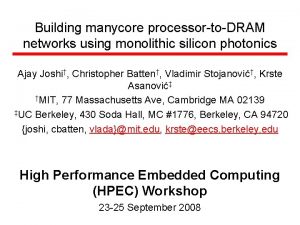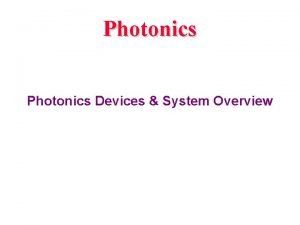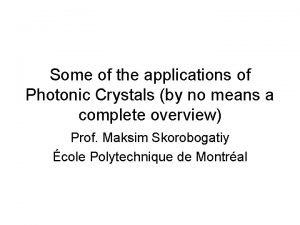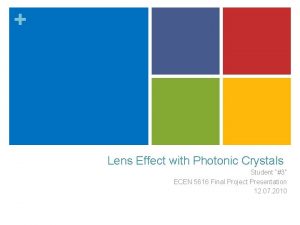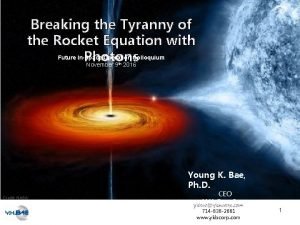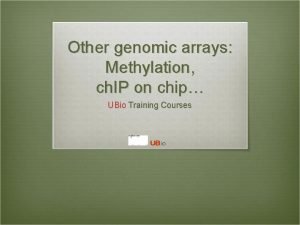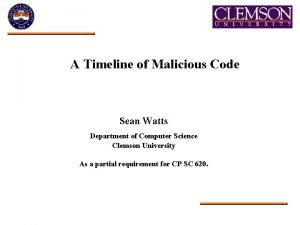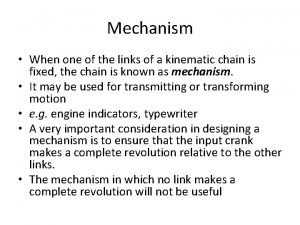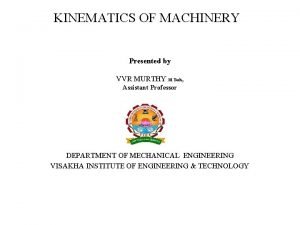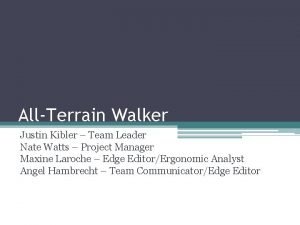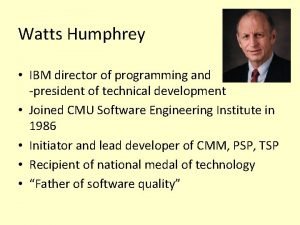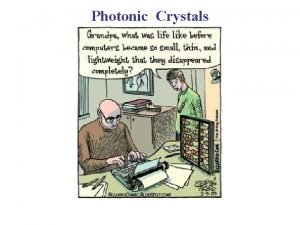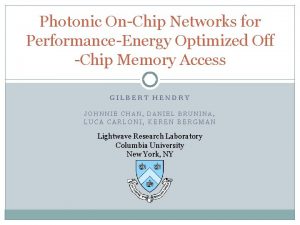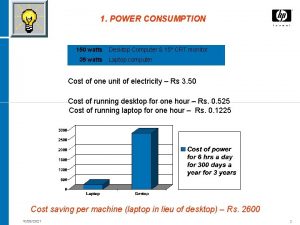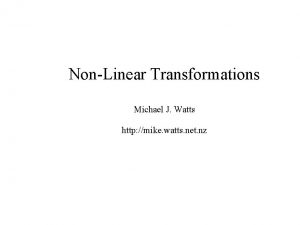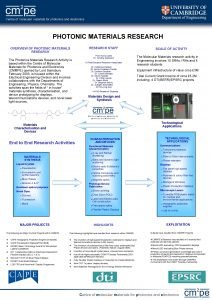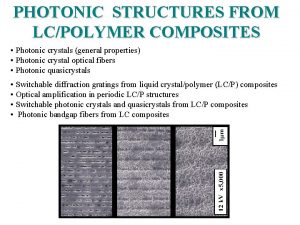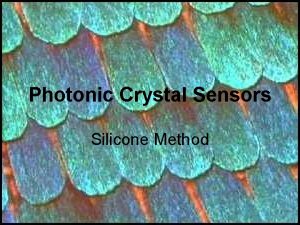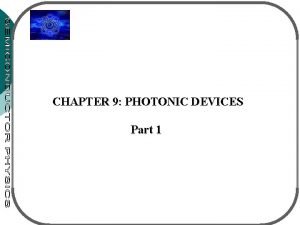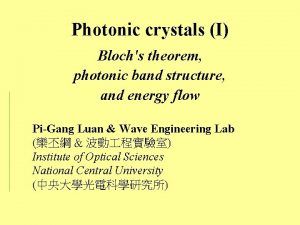Exploring Chip to Chip Photonic Networks Philip Watts




















- Slides: 20

Exploring Chip to Chip Photonic Networks Philip Watts Computer Laboratory University of Cambridge Acknowledgement: Royal Commission for the Exhibition of 1851

Exploring Chip-to-Chip Photonics • Bandwidth improvements in electronic interconnects have been achieved at the expense of increased latency and power consumption • Photonics has the potential to reduce power consumption/ latency – Known for a long time, BUT size, cost, manufacturing issues – Enabling technologies: silicon photonics and 3 D integration • Needs a holistic, system assessment – assessing power consumption and performance

Photonics: Low Power and Latency ? • For point-to-point links: – Photonics power consumption is not dependent on distance, only on modulator/detector capacitance • Electrical interconnect power increases exponentially with distance – Photonics is not pin limited • Large bandwidth, low latency using by wavelength multiplexing • Switched systems: – Photonics switching power is not dependent on bandwidth • Electronic routers, power and latency consumed for each hop/buffer

Enabling Technology 1: Silicon Photonics What’s changed? • Compact waveguides in Si/Si. O 2 – Compact and low cost Source: Intel • Off-chip, polymer waveguides – Integration on Copper PCBs 1. 4 m long spiral polymer waveguide with input from He. Ne laser • Ring resonators can modulate, switch and filter – Switch/Modulate at >10 Gb/s Appropriate detectors and light-sources already exist Diagram: M. Lipson (Cornell)

Enabling Technology 2: 3 D Integration • Recent advances in 3 D point toward multiple cores + DRAM layers (≈1 GB) + network within a single package • Combine such modules to produce larger systems for data centres or high performance computing • III-V substrates for light sources can be integrated

Characteristics of a Photonic Network • Photonic Limitations: – Signals can not be (practically) buffered – Difficult to read header and setup switch on the fly • These limitations leads naturally to circuit switching (with edge buffers) – Photonics is good for flows/large packets – Relatively inefficient for small packets (e. g. cache lines) • Obvious network choice: Central Xbar/Clos switch with time slot access, e. g. SWIFT (Intel/Cambridge) – Various alternative distributed approaches proposed

FPGA-based Full System Emulation • FPGA-based emulation enables full system power/performance data using realistic workloads/timescales – 100 x faster than software simulation – Existing Computer Lab project, C 3 D, provides BEE 3 infrastructure, cores and all-electronic reference design • Emulate 1000+ core computer with photonic chip-to-chip network model – 4 high-end FPGAs per board – 4 -8 MIPS-64 cores per FPGA – Clock rate ≈ 100 MHz • Levels of model abstraction – Parameterisable and synthesisable System. Verilog network model – Photonic component power consumption model – Photonic path viability model Features of BEE 3 board (UC Berkeley/Microsoft)

Exploring Chip-to-chip Photonics • Collaborators: Myself, Andrew Moore, Simon Moore (Cambridge), Robert Killey (UCL EE) • Program to investigate implications of chip-to-chip photonic interconnect on architecture of: – Data Centres – High Performance Computing • Build accurate and experimentally verified models of latest silicon photonics components (UCL) • Build full system FPGA-based emulator – Allows rapid network architectural exploration – Find applications which benefit from photonic networks

Backup

Distributed Switching • Cross-bar approach is limited by N 2 scaling and complexity of arbitration/allocation Columbia University Photonic No. C with Electronic Overlay – Example IBM/Corning OSMOSIS for 2000 ports/50 m diameter • Alternatives using distributed switching – Mesh/Torus networks • path must be setup in advance => only suitable for large blocks of data – Wavelength encoded address • Packets dropped on contention => head of line blocking Columbia University Spin. Net

Ring Resonator Applications Modulating multiple signals (1 -20 GHz) onto multiple wavelengths on a single waveguide 4 port switch - switching multiple wavelengths simultaneously (e. g. 16 wavelengths x 10 Gb/s = 160 Gb/s) Reverse process used to demultiplex wavelengths to recover individual signals Diagrams: K. Bergman (Columbia), M. Lipson (Cornell)

3 D/Si. P Technology • 3 D/Si. P allows various processes including III-V substrates to be integrated in one package Source: IBM

SOA Switching • CAPE speciality • SOAs have amplification so no power budget issues • Can switch large bandwidth • High power – Require temperature stabilisation

Lockside Performance • 4 x 4 mesh network • 64 x 250 Mb/s = 16 Gb/s per link • Designed for on chip – Plenty of wiring resources available • For off-chip, each node would require 256 signal pins • Lightly loaded photonic cross -bar latency = 2 cycles (for 18 packet length)

Example: Photonic Cross-bar • Min slot time = (RTT to switch) + (arbitration time) ≈ 15 ns for 1 m network radius – – Switching time with ring resonators is v. low Min latency = 2 slot times ≈ 30 ns 128 b packet only uses 800 ps! 15 ns also allows 280 B per slot (16λ x 10 Gb/s) • Currently creating initial model of chip-to-chip photonic network to add to C 3 D system – Compare with electronic VC router network • Initial design: – – – 32 Nodes each serving a 32 -core chip = 1000 cores 4 boards with 8 chips per board Central x-bar switch, centralised routing and arbitration, fixed time slots Network radius = 1 m Node bandwidth: 16 wavelengths at 5 -10 Gb/s each = 80 -160 Gb/s

Multiple Networks • An idea that repeatedly comes up in literature: Two networks – One for large packets/flows • Photonic, circuit switched or with long slot – One for short packets, could be: • Photonic with minimum slot time • Electronic • Point 2 point photonic • Local (covering a single PCB) and global networks – Centralised cross-bar removes locality • Additional networks for broadcast/multicast – High bandwidth photonic signals can be split many ways without impedance matching issues – However, power budgets! • This is an area where Semiconductor Optical Amps may be useful

Photonic Interconnect • Some improvement in power and bandwidth/distance is obtained by simple replacement of electrical cables with fibre – We are interested in minimising power consumption using efficient switching and wavelength multiplexing • Interested in this ↓ not this ↓

Communication Centric Computer Design (C 3 D) • Computer architecture group project to investigate communications in multi-core systems – – Implementation technology Architecture Algorithm mapping Programming • Need accurate power consumption/performance data for full system On-chip multi-core network using VC routers [Mullins 2006]

Silicon Photonics - Waveguides • Compact waveguides in Si/Si. O 2 – 400 x 200 nm typical – Bend radius ≈ few μm • Compact circuits – Low loss – CMOS compatible manufacturing • Low cost • Off-chip, polymer waveguides on PCB are in development Source: Intel

Silicon Photonics – Active Devices • Ring resonators can modulate, switch and filter – 3 -50 μm diameter – Capacitances <5 f. F • Low power – Switch many wavelengths simultaneously – Modulation >10 Gb/s demo’ed • Ge photodetectors integrated with silicon waveguide – 20 GHz bandwidth with high responsivity • Only need a light source – Can be off-chip Diagram: M. Lipson (Cornell)
 Photonic chip paperclip
Photonic chip paperclip What is optoelectronics
What is optoelectronics Sopmed training
Sopmed training Andy moir photonic
Andy moir photonic Applications of photonic crystals
Applications of photonic crystals Finite difference time domain
Finite difference time domain Andy moir photonic
Andy moir photonic The tyranny of the rocket equation
The tyranny of the rocket equation Methylation & chip-on-chip microarray platform
Methylation & chip-on-chip microarray platform Virtual circuit approach
Virtual circuit approach Basestore iptv
Basestore iptv Ohms
Ohms Sean watts
Sean watts Watt indicator mechanism
Watt indicator mechanism Kutzbach criterion
Kutzbach criterion Justin sconza
Justin sconza Watts bar
Watts bar Watts electricidad
Watts electricidad Charlie watts
Charlie watts Dr jacqueline watts
Dr jacqueline watts Watts humphrey
Watts humphrey
